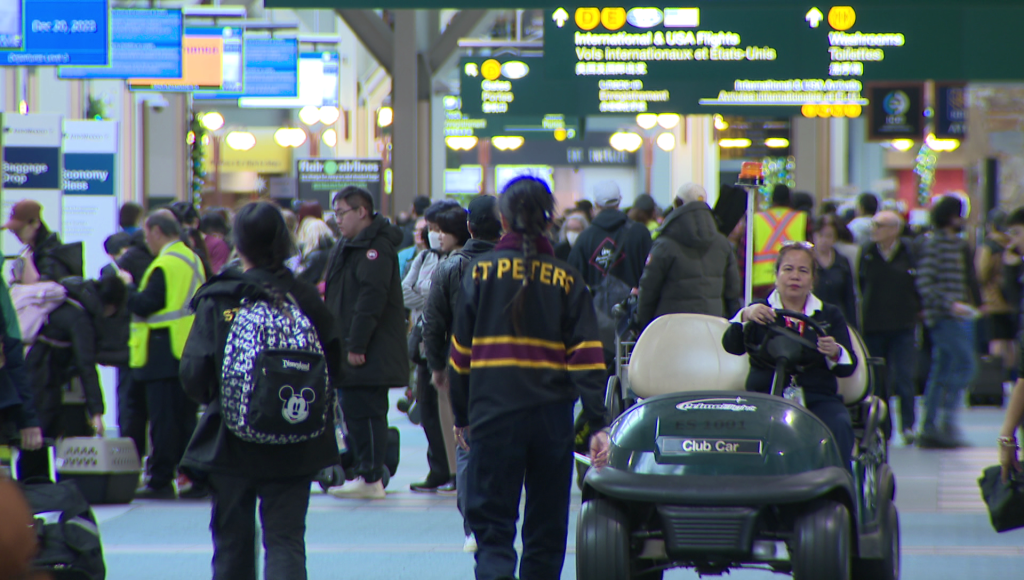Refugee claimants arrive at B.C. airports in unprecedented numbers

Posted January 18, 2024 8:45 pm.
Last Updated January 19, 2024 9:43 pm.
The number of people arriving at airports in B.C. to make a refugee claim in 2023 has doubled compared to 2022, and that’s before the federal government released the numbers for December of last year.
From January to November, 630 travelers made refugee claims at the province’s airports, according to Immigration, Refugees and Citizenship Canada. Only 350 people were processed at B.C. airports in 2022, and 335 before the pandemic in 2019. The number was as low at 80 claimants for the entire year in 2015.
This upward trend is being seen across Canada, with Quebec processing 23,245 claimants at the province’s airports between January and November in 2023. That’s compared to the 11,664 applications received in 2022.
Katie Crocker, CEO of the Affiliation of Multicultural Societies and Service Agencies in Vancouver, says the uptick in refugees arriving by air is most likely a result of global crisis and ongoing wars and the Canada-U.S. “safe third party agreement”
The agreement “means if someone comes through the land border and makes a refugee claim at the border here in Cananda, they can be sent back to the U.S. because it is deemed a safe country,” Crocker said.
Not all refugee claimants need support as soon as they arrive at a Canadian airport. But many do, says Loren Balisky, director of engagement at Kinbrace Refugee Housing and Support.
The agency represents just a handful of organizations in Vancouver equipped to receive and provide guidance to newcomers who need help with accommodations and navigating the immigration system.
“The numbers are incredible, if you look back to 2011. That year, the number (of asylum claimants processed by the Canada Border Services Agency and Immigration, Refugees and Citizenship Canada (IRCC) was just 25,000. Last year, not including December, the number was 128,000. That’s 100,000 claimants in just one year,” noted Balisky.
He stresses their resources have always been stretched.
“We’ve always been in crisis mode, but when those numbers keep increasing, it’s just crisis amplified for the claimants and the charities who support them until they get status and can be independent,” Balisky said. “Large refugee settlement agencies are tapped out.”
Kinbrace works on referral basis, meaning claimants get help only after going through another party. It operates six transitional housing units, and can only accomodate 30 to 40 refugee claimants a year. The Immigrant Services Society of BC has what it calls “18 flexible living units for refugees.”
Asylum seekers are winding up in Vancouver’s homeless shelters, Balisky says.
“There’s a shelter downtown which said 95 per cent of their occupancy is refugee claimants,” Balinski said. “They’ve never had that before. It used to be around five per cent. It’s a huge stress on everything.”
The number of asylum seekers taking up space in Lower Mainland homeless shelters is difficult to quantify. The Union Gospel MIssion in Vancouver, for example, says it doesn’t ask people their status when they arrive at the shelter. Although the organization located in the Downtown Eastside says it does serve refugees, they are not the majority of the people who use its services.
Soloman Atta, Operating Manager at the Catholic Charities Men’s Shelter, says he has seen the percentage of shelter spaces occupied by refugees jump over the last year.
“October last year, the number increased and we had about 50 per cent of the shelter space being occupied by refugees at that time,” Atta said. “That increased to 56 per cent in November, and by December, we had about 60 per cent of our shelter space occupied by refugees.”
But Balisky says the shelters aren’t suitable for the newcomers.
“Refugee claimants are often retraumatized when they enter into homeless shelters here because they are exposed to people with addicitons and mental health problems,” he said.
He points out it can be months before an asylum seeker is given the go-ahead to apply to become a refugee, and a surge of applicants just adds to the backlog.
“People are living in survival mode, trying to make ends meet and trying to navigate the refugee system,” he said.
The surge in asylum seekers arriving at Canadian aiports can be partially attributed to the federal government restricting irregular land border crossings at places such as Roxham Road in Quebec.
Refugee claims received at land border crossings dropped from 46,000 in 2022 to 27,000 last year, according to Immigration Canada. This past year, the federal government also lowered the eligibility bar for people seeking visitor’s visas, which enables more people to travel to Canada, where they can make a claim.
This week, Quebec Premier Francois Legault pleaded with the Trudeau government to stem the tide of refugees, saying services in his province were at a “breaking point.”
Toronto is toying with a tax increase to fund more shelters for asylum seekers. The city estimates 5,800 refugee claimants are using up more than half of the city’s shelter capacity.
Katya Avalos, community engagement director for the Multi-Agency Parnership, says Canada is one of the hardest countries to immigrate to legally, so many are forced to prove they are not safe in their countries and need asylum here.
“We are in a point in history where we have the highest number of forcibly displaced people around the world, and Canada is seen as a humanitarian country,” Avalos said.
Crocker says they’ve seen that once a refugee claimant settles in, they do very well in Canada.
“They are resilient and resourceful,” she said. They are motivated to make a good life for themselves. They aren’t here to country shop; they’re here to be safe and they are very well integrated into Canadian society once they have access to those supports.”
With files from Angela Bower.








